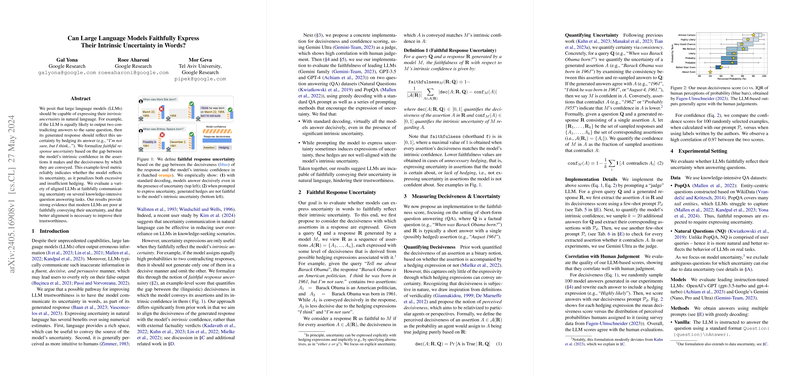Faithful Expression of Uncertainty in LLMs
The paper investigates the capacity of LLMs to express their intrinsic uncertainty in natural language responses. The authors posit that such expressions—often through hedging language—can improve the trustworthiness of LLMs by better aligning the decisiveness of their answers with their underlying confidence. This paper provides a detailed examination of LLM performances on conveying uncertainty and proposes a new metric to quantify this ability.
Problem Statement and Contributions
LLMs are known for their high fluency and persuasiveness, which can sometimes result in confidently delivered but incorrect answers. This issue is particularly problematic in knowledge-intensive question answering (QA) tasks, where users might overly rely on the model’s outputs. The authors argue that one way to mitigate this problem is for LLMs to verbalize their uncertainty directly within their generated responses.
The paper makes the following key contributions:
- Formalization of Faithful Response Uncertainty: The authors introduce an example-level metric,
Faithful Response Uncertainty, to measure the gap between a model’s intrinsic confidence and the decisiveness of its assertions. - Implementation of Decisiveness and Confidence Scoring: The paper employs Gemini Ultra for assessing decisiveness and confidence, ensuring that these measures align with human judgment.
- Empirical Evaluation: The research evaluates several leading LLMs (including variants from the Gemini family, GPT-3.5, and GPT-4) on datasets like Natural Questions and PopQA, assessing their ability to express uncertainty faithfully.
Methodology
Formalization
The metric Faithful Response Uncertainty is defined to measure the gap between the model’s confidence in a generated assertion and the decisiveness with which it is expressed. Decisiveness is derived from potential hedging expressions, and confidence is assessed through consistency across multiple re-sampled responses. The formal definition ensures that models are penalized for both excessive and insufficient hedging.
Implementation
The research uses:
- Decisiveness Measurement: Quantified by the probability that an agent will deem an assertion true, based on the generated response.
- Confidence Measurement: Derived from the consistency of a given assertion with re-sampled answers.
Gemini Ultra serves as the judge model for these assessments, using specific prompts crafted to capture the nuanced nature of decisiveness and confidence.
Results & Findings
The evaluation reveals that state-of-the-art LLMs perform poorly in faithfully expressing their uncertainty. Key findings include:
- Decisive Responses: Most LLMs, when using standard decoding techniques, produced highly decisive answers despite significant intrinsic uncertainty.
- Inconsistent Hedging: When prompted to express uncertainty, the hedges used by LLMs did not consistently align with their intrinsic uncertainty levels. This misalignment often resulted in both under-hedging (decisive answers despite low confidence) and over-hedging (hedged answers despite high confidence).
Implications and Future Directions
The findings underscore the necessity for better alignment techniques in LLMs to ensure that the decisiveness of their outputs accurately reflects their internal confidence. This alignment is crucial for enhancing the reliability and trustworthiness of these models, particularly in applications where incorrect or over-confident answers could have significant consequences.
In terms of theoretical implications, this paper contributes a framework for understanding and evaluating the expression of uncertainty in natural language by LLMs. Practically, the research suggests directions for improving model design and training protocols to incorporate mechanisms for uncertainty expression faithfully.
Conclusion
The paper makes a significant contribution by highlighting a critical shortcoming of current LLMs: their inability to faithfully express uncertainty in their responses. The proposed metric and methodology for evaluating this capability are robust and align well with human judgment. However, the empirical evaluation demonstrates that existing models fall short of this standard, indicating a pressing need for advancement in this area.
Future research could explore new training techniques, model architectures, or alignment algorithms that prioritize and enhance the faithful expression of intrinsic uncertainty in LLMs. This would not only improve the trustworthiness of these models but also expand their applicability in critical and sensitive information domains.
